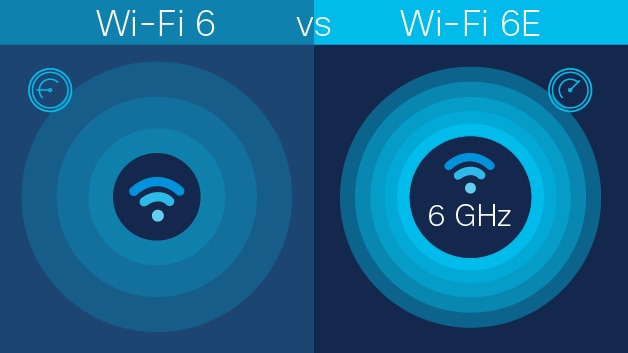Top benefits of Wi-Fi 6E
Today’s network needs to serve the entire workforce—which increasingly depends on a mix of in-office, remote, and hybrid work models—as well as the devices and apps that support workers’ productivity and safety.
Flexible, scalable, reliable, and secure wireless networks are crucial to supporting today’s mobile, collaborative, and data-driven businesses.
With that in mind, the following benefits of Wi-Fi 6E stand out as the most important:
Speed
Wi-Fi 6E devices, including smartphones, wireless laptops, wearable devices, and IoT sensors, can transmit data very rapidly using the 6-GHz band. Also, there are no slow, legacy devices competing for bandwidth in this newly expanded spectrum.
Those advantages make Wi-Fi 6E ideal for supporting high-resolution streaming video, online gaming, teleconferencing, and other bandwidth-intensive applications. Use cases include augmented reality (AR), virtual reality (VR), and transfers of extremely large data files, such as MRI images in healthcare.
Security
Wi-Fi 6E benefits organizations that want or need highly secure networks. The Wi-Fi Alliance has made Wi-Fi Protected Access 3 (WPA3) mandatory for all Wi-Fi 6E devices, without backward compatibility for WPA2 security. These measures can increase user confidence in moving to the 6-GHz frequency band for their most trusted connections.
Also, the Wi-Fi Alliance is requiring Wi-Fi Enhanced Open certification support for the 6-GHz spectrum. The Enhanced Open specification is based on the Opportunistic Wireless Encryption (OWE) specification. OWE is defined in the Internet Engineering Task Force (IETF) RFC 8110 specification and the Wi‑Fi Alliance Opportunistic Wireless Encryption Specification. OWE is optional in Wi-Fi 6E.
OWE protects the communication between each pair of endpoints from other endpoints.
Industries where Wi-Fi 6E can transform business
Enterprises in any industry can benefit from using Wi-Fi 6E, but Wi-Fi 6E networks are likely to make a dramatic impact in the following sectors:
Healthcare
Healthcare providers can connect more lifesaving devices to Wi-Fi 6E networks with far fewer data delays or other slowdowns. Wi-Fi 6E also supports data-intensive apps and services for transferring large data files, such as MRI images, and it helps ensure higher-quality connections and fewer interruptions for telehealth appointments.
Retail
Wi-Fi 6E will make point-of-sale connections in retail environments faster, which can shorten checkout lines and reduce customer frustration. In turn, customers can make more purchases quickly and easily. And a better customer experience enhances brand reputation, which also helps to increase sales.
Education
Wi-Fi 6E can help educational institutions provide high-quality immersive and virtual learning experiences to students throughout the school day. That's because the large contiguous blocks of spectrum that Wi-Fi 6E provides will support high throughput and concurrent data transmission.
Students with Wi-Fi 6E devices can take advantage of the 6-GHz band, while students with older devices can continue to use the 2.4-GHz and 5-GHz bands, where traffic loads will be lighter. A major result will be enhanced wireless connectivity and performance for all students using school networks.
Manufacturing and warehousing
Any organization in manufacturing or warehousing that is considering adding IoT devices and sensors to its network environment will want to take advantage of the nearly interference-free band used by Wi-Fi 6E.
Organizations can deploy Wi-Fi 6E IoT devices on the 6-GHz spectrum and segregate them from day-to-day business traffic. While office workers are using the 5-GHz or 2.4-GHz band for activities such as reading email and searching the internet, Wi-Fi 6E devices on a manufacturing floor or in a warehouse can run efficiently in the 6-GHz band.
The results are more reliability and lower latency for the IoT devices that use Wi-Fi 6E and an improved ability for businesses to meet their service-level expectations.
The industries mentioned above are just examples of industries that are likely to see significant benefits from using the Wi-Fi 6E extension.
Here's a recap of some of the top advantages of using Wi-Fi 6E that organizations may want to take into account as they consider upgrading their wireless infrastructure to support Wi-Fi 6E:
- Access to up to 2.5 times more spectrum
- A better voice and video experience
- Higher network speeds
- Stronger security
